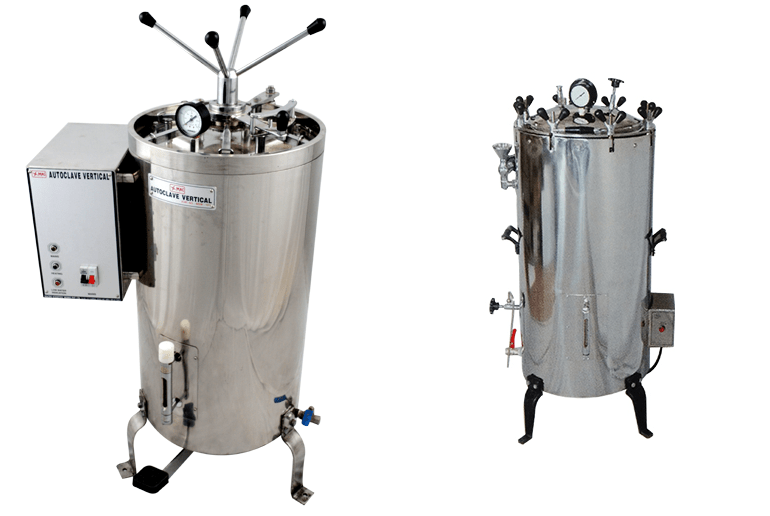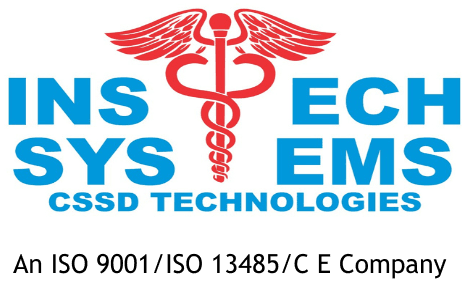Vertical Autoclave Manufacturer
- Precise Sterilization by Automatic Pressure Control Switch & Timer
- All Argon Arc Welded Double walled construction for durability & safety .
- Multiple Valves for Safety by Spring Loaded, Vacuum Break & & Dead Weight
- Gauge Glass, Water Filling, Drain & Steam Ejection Valves
- Wing Nut (Radial Arms optional) closing arrangement with jointless Elastomer Gasket for Leak proofing.
- Pressure Gauge & Timer standard (Digital Temp. Controller & Timer Optional)
- Audio Visual Alarm for process completion and safety alarm facility.

Capacity | Interior (m) | Power (KW) |
22 | 250*450 | 2.0 |
35 | 300*500 | 2.0 |
52 | 350*550 | 3.0 |
76 | 400*600 | 4.0 |
224 | 450*600 | 5.0 |
175 | 550*750 | 0 |
Pressure 0.0 to 2.2 bar
Temp. Range 100 to 135 degree C (with digital controller)
Control Panel With mains & load indicator mains switch, low water & timer
Housing Material CRC powder coated / SS 304 Polished
Interior Polish SS 304 grade (SS 316 Optional)
Door Plate Thick SS 304 with Hinge
Power 220/230v AC supply 10% 50 HZ
A vertical autoclave is a sterilizing device with a cylindrical shape, It is also known as horizontal and vertical autoclave and top loading sterilisers. Medical equipment, surgical tools, to name a few, can be sterilised with the use of these machines. One of the most important medical procedures is sterilisation, which is used in numerous fields, including food and healthcare. In order to sterilise flasks, medical instruments, beakers, etc., this equipment operates on the principle of high-pressure steam. These machines are offered in a variety of configurations, including GMP construction, Double Wall Construction, and Triple Wall Construction, depending on the industry and need.
Frequently Asked Questions (FAQs)
A Vertical Autoclave is a specialized pressure chamber used in laboratories and medical facilities for sterilizing equipment, glassware, and media using steam and high pressure. It is particularly well-suited for applications where vertical space is limited.
The autoclave uses a combination of high-pressure steam and elevated temperatures to kill or inactivate microorganisms, ensuring that items inside the chamber are sterilized. The items are placed on trays or racks within the autoclave, and the chamber is sealed for the sterilization cycle.
Vertical autoclaves are designed to sterilize various laboratory equipment, glassware, medical instruments, and other items that can withstand high temperatures and pressure. This includes surgical instruments, culture media, laboratory glassware, and more.
- Effective sterilization
- Reliability and consistency
- Suitable for limited vertical space
- User-friendly controls and safety features
- Versatile for a wide range of applications
Vertical autoclaves are used in microbiology laboratories, research facilities, hospitals, and pharmaceutical manufacturing for sterilizing equipment, laboratory media, surgical instruments, and any items that require absolute sterility.
Items to be sterilized are loaded onto trays or racks and placed inside the autoclave chamber. Once the sterilization cycle is complete, the autoclave is depressurized, and items can be safely unloaded.
Safety is paramount when operating an autoclave. Users should follow the manufacturer’s guidelines for loading, securing, and monitoring the autoclave during operation. Wearing appropriate personal protective equipment is essential.
Regular maintenance is essential to ensure the autoclave’s functionality. This may include cleaning, calibration, routine inspections, and adherence to the manufacturer’s maintenance schedule and recommendations.
Yes, you can sterilize liquids in a vertical autoclave. However, it’s essential to use appropriate containers and follow recommended procedures to prevent spillage or over-pressurization during the sterilization process. Care should be taken to avoid contamination and ensure safety.
